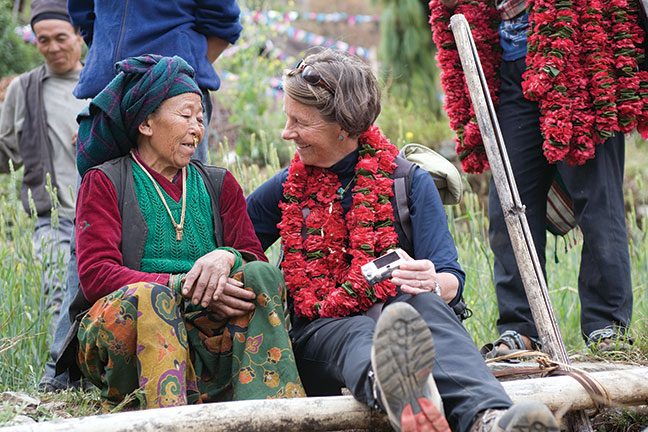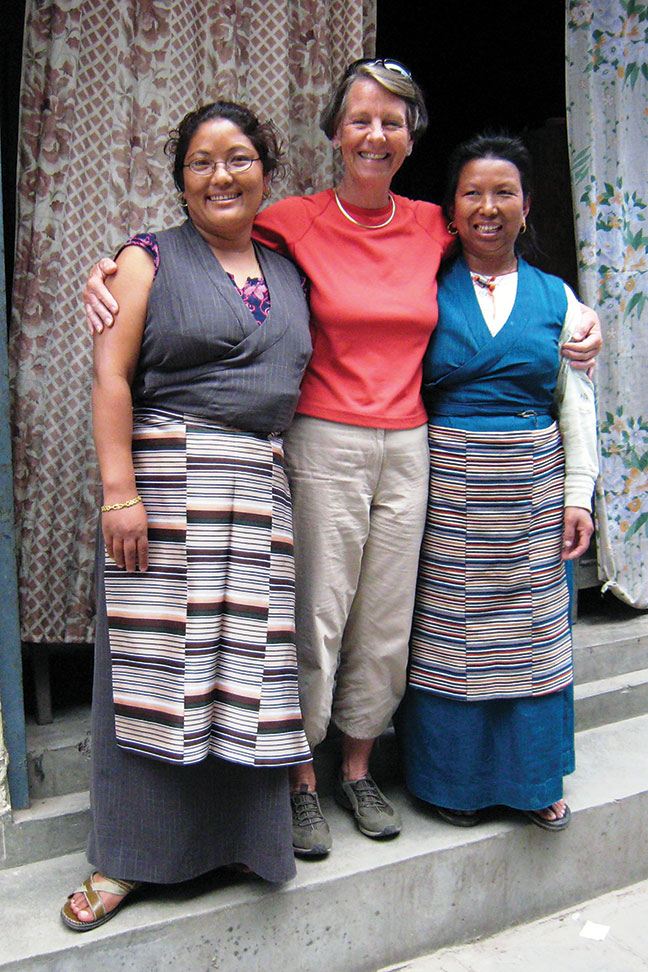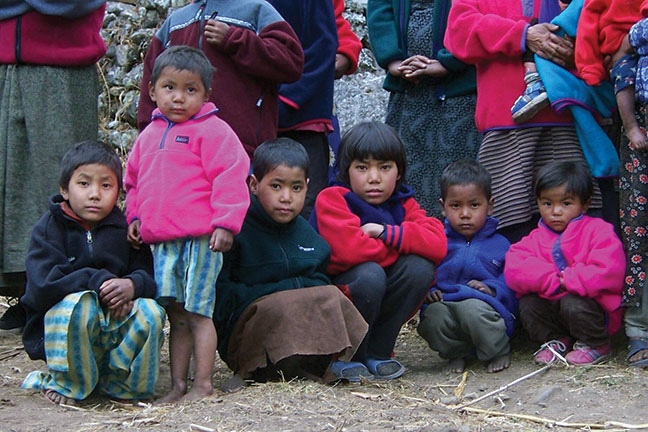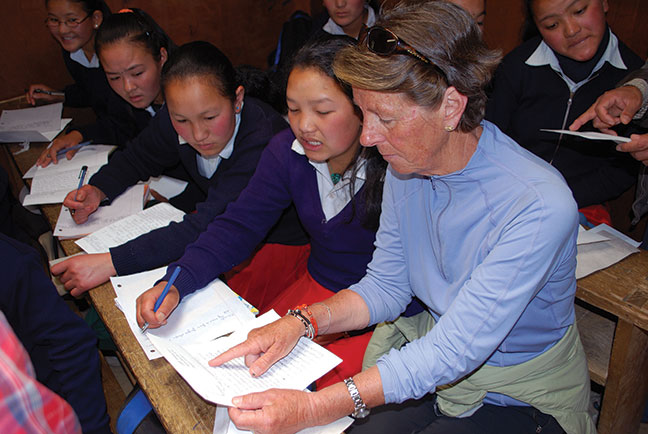Every time she goes to Nepal, she takes a piece of the South Coast with her. Actually, make that many pieces of the South Coast. In reality, it is more like eleven body-sized duffle bags filled with hundreds of donated fleece jackets and caps from South Coast residents.
So naturally, when Sally Hunsdorfer returns home to Marion, she brings with her a piece of Nepal. Within Sally is a passion for a strange, surreal land that lies hidden, high up in the clouds, halfway around the world. Also within Sally is a commitment to the joyful, peaceful Sherpa people who welcomed Sally into their culture, resulting in many changed lives.
Sally shared her passion for Nepal with the community on the evening of January 16 during an educational and inspirational presentation, with tremendous tales of adventure and beauty, accompanied by breathtaking photos that had the audience mesmerized, inspired, broken-hearted at times, and every so often wondering, is this woman crazy?
Fifteen years ago, Sally and her husband, Peter, did what many people usually only dream about doing. They pulled their two teenaged sons out of high school and went backpacking for a year around the world. During that journey, Sally came to recognize Nepal as a special place for her; specifically, the village of Chaurikharka, which she affectionately called “the village where I hang my hat.”
Nepal is a country of 26 million people, land-locked between China and India, and known for the world’s highest mountain, Everest. The ancient salt trading routes that cut through the Himalayan Mountains make up the network of trekking trails outside and away from the nation’s capital, Kathmandu.
Beneath the large screen in the darkened theater of the Marion Music Hall, Sally stood dressed in the traditional clothing of a married Sherpa woman and, without having to say much, captivated the audience with a photography slideshow set to the rhythmic drumming and deep chanting voices of the tribal music of Nepal.
The audience gasped at the beauty of white, jagged, uninhabited glacial passes and peaks from airplane windows; the brown earth of mountains against a stark unimaginably blue sky; primitive dwellings forged out of the scarce resources of the Himalayan landscape.
Children’s smiles, and intimate close-ups of happy, peaceful faces; Sherpa people making impossible treks up mountains beneath the crushing weight of crates and wood; young and old, spiritual men praying, people dressed in colorful cloths; rampant poverty and absolutely none of the comforts of the western world.
“I can assure you,” Sally spoke, “that these people are as beautiful on the inside as they are on the outside.”
Sally began with the principle of “Namaste,” giving the definition of the word one hears hundreds of times a day in Nepal, and how it breaks down barriers between people.
“It is a way of saying, ‘the spirit in me greets the spirit in you,’” said Sally. “If I say ‘I honor everything that is unique and wonderful about you’ (Namaste), it might not be as easy to point a gun at somebody.”
After the Hunsdorfers’ two-month stay in Nepal during their year backpacking, Sally wanted to go back, but the next time with a purpose.
“I had this visceral pull to get back there,” said Sally. “And that’s when the Himalayan Project was born.”
She described the project’s mission as a dedication to enhancing education, enriching community development, and providing social outreach.
“And I wanted to form a way to connect American children with their peers from across the world.”
Sally collected about 900 fleece jackets from students in local schools and from within the community. Her documentation of the journey of the jackets starts from when they are first sorted into tall, colorful piles according to size in the middle of Sally’s kitchen, to laying out the gigantic, black duffle bags completely stuffed with fleece in her back yard, to being loaded onto a bus she rented to bring them to Logan Airport.
From there, Sally and the fleece would arrive in Kathmandu. The duffle bags are then piled into a small propeller plane to fly them over the Himalayas to land at the same very basic airstrip used by Mt. Everest trekkers. They are then loaded onto the backs of yaks and Sherpa men who carry the loads through the treacherous Himalayan trails to the village of Chaurikharka, which means “yak pastures” – about a week-long trek, with no roads beyond 50 miles of the capital.
“Everything has to be carried out on somebody’s back or a beast of burden,” said Sally.
No heat, no electricity, and no running water – but there is joy. “Utter joy,” says Sally. “There is always time for joy and merriment.”
After the long trek, they finally arrive at the village, at which time Sally says she just steps aside and allows the Sherpas who carried the loads to open the duffle bags and unpack the fleece jackets for the people, content to watch the scene unfold. Sally is, after all, a sight some people living in the highest peaks of the Himalayas might never see during their lives.
“A lot of times the babies burst out crying when they see my face,” said Sally. She has, though, been fully embraced by the Sherpa people of Chaurikharka, and Sally has dedicated her time not only bringing fleece to the village but also coordinating efforts at home to collect donations for other projects, like the school house improvement project when they fixed up the existing school and added a gathering house, cafeteria, and greenhouse.
Since Sally’s involvement, the school has been able to add grades 11 and 12, and has provided school supplies and furnishings for the school.
Sally has also undertaken other projects, like the 100-Day project, in which she collected 100 pencils, 100 notebooks, and 100 of other items from South Coast students, and the students at Keith Middle School in New Bedford sewed fleece hats from donated fleece material.
When she returns, she gives students a presentation and shows her the photos of the items’ journey into the hands of the Sherpa children.
“Look at the difference it made halfway around the world,” Sally said she told the students. “There wasn’t a dry eye.”
Sally also acts as liaison for a pen pal initiative she started between the Sherpa students and the students at Sippican School. She said the kids love the exchange, sharing photos and learning about what each of them does “when they hang out.”
“It’s just to give [the Sherpa students] an idea that the outside world knows they exist and is interested in their lives,” said Sally.
Watching Sally’s presentation about the lives of the people of Nepal evoked in many a sense of some ambiguous dichotomy of envy and gratitude, at the same time. Envy for the simplicity, the free-flowing joy of the Sherpas, and innocence of simple Sherpa life; yet, grateful for the comforts we enjoy, aware that, as beautiful as life might appear to outsiders looking in, any one of those people might change places with you in a heartbeat, if they could.
For more information about the Himalaya Project or to make donations, visit www.himalayanproject.org, or contact the Marion Institute and indicate that you would like to make a donation to the Himalayan Project. The Himalayan Project can also be found on Facebook.
By Jean Perry



